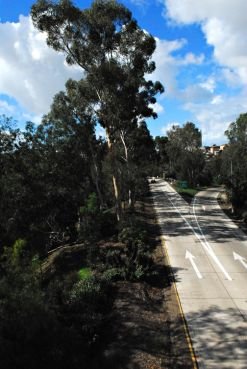 Facebook
Facebook
 X
X
 Instagram
Instagram
 TikTok
TikTok
 Youtube
Youtube

Residents of University Heights refer to the canyon underneath the Vermont Street Bridge (over Washington Street and near the onramp for Highway 163) as the “dead zone,” a trash-filled netherworld covered with dried-up palm fronds, discarded clothing, and moldy bedding from the homeless encampments spread throughout the ravine.
For years, the community has considered ways to make the area useful. Two years ago, University Heights resident Rhett Butler volunteered to find a solution. In that time, he’s spent over 200 hours and a couple of thousand dollars from his own pocket, looking for ways to bring the area back to life. He collaborated with North Park resident and landscape architect David McCullough, and the two devised a plan to transform the canyon wasteland into a community park.
Inside Birney Elementary School Auditorium on Thursday, February 5, at the monthly University Heights Community Association meeting in front of Councilmember Todd Gloria, Butler and McCullough unveiled their plan, calling it, “Mystic Park.”
The park includes a children’s playground, open space for summer concerts, a dog park, and a sidewalk that connects University Heights to north Hillcrest.
There are some obstacles Butler and the University Heights Community need to overcome before the “dead zone” can come alive.
The first challenge is finding the mountain of dirt to fill the canyon just north of Washington Street.
“It’s previously disturbed land,” Butler said during his presentation, referring to when the land was moved to make way for the highway and the Washington Street extension back in 1948. “And that’s why we have the opportunity to fill this in and make it into a park.”
As far as filling the canyon, Butler hopes to persuade new developments to dump their dirt into the canyon, possibly charging private companies to dump their unwanted dirt in the canyon instead of hauling it to Miramar Landfill.
The next obstacle is convincing Caltrans to reroute the Highway 163 onramp.
Butler says because the land is owned jointly by the state and the city, acquiring the land won’t cost any money; and because of the daily traffic snarl that takes place at Washington and the 163, the transportation department shouldn’t protest rerouting the ramp.
Although Butler was reluctant to put a timeline on the project, he says if everything goes right, construction could start in a few years. He plans to do all he can before handing it over to the city. That means finding volunteers that are architects, traffic experts —anybody that help.
“It won’t happen if I give it over to the city. It will get mired down and they’ll soak up any of the money from the community as far as using up any funds from development impact fees. I don’t want to see that happen.”
To find out how you can help, or if you have a few thousand tons of extra dirt lying around, go to uhsd.org, or contact Butler directly at 619-806-0808.


Residents of University Heights refer to the canyon underneath the Vermont Street Bridge (over Washington Street and near the onramp for Highway 163) as the “dead zone,” a trash-filled netherworld covered with dried-up palm fronds, discarded clothing, and moldy bedding from the homeless encampments spread throughout the ravine.
For years, the community has considered ways to make the area useful. Two years ago, University Heights resident Rhett Butler volunteered to find a solution. In that time, he’s spent over 200 hours and a couple of thousand dollars from his own pocket, looking for ways to bring the area back to life. He collaborated with North Park resident and landscape architect David McCullough, and the two devised a plan to transform the canyon wasteland into a community park.
Inside Birney Elementary School Auditorium on Thursday, February 5, at the monthly University Heights Community Association meeting in front of Councilmember Todd Gloria, Butler and McCullough unveiled their plan, calling it, “Mystic Park.”
The park includes a children’s playground, open space for summer concerts, a dog park, and a sidewalk that connects University Heights to north Hillcrest.
There are some obstacles Butler and the University Heights Community need to overcome before the “dead zone” can come alive.
The first challenge is finding the mountain of dirt to fill the canyon just north of Washington Street.
“It’s previously disturbed land,” Butler said during his presentation, referring to when the land was moved to make way for the highway and the Washington Street extension back in 1948. “And that’s why we have the opportunity to fill this in and make it into a park.”
As far as filling the canyon, Butler hopes to persuade new developments to dump their dirt into the canyon, possibly charging private companies to dump their unwanted dirt in the canyon instead of hauling it to Miramar Landfill.
The next obstacle is convincing Caltrans to reroute the Highway 163 onramp.
Butler says because the land is owned jointly by the state and the city, acquiring the land won’t cost any money; and because of the daily traffic snarl that takes place at Washington and the 163, the transportation department shouldn’t protest rerouting the ramp.
Although Butler was reluctant to put a timeline on the project, he says if everything goes right, construction could start in a few years. He plans to do all he can before handing it over to the city. That means finding volunteers that are architects, traffic experts —anybody that help.
“It won’t happen if I give it over to the city. It will get mired down and they’ll soak up any of the money from the community as far as using up any funds from development impact fees. I don’t want to see that happen.”
To find out how you can help, or if you have a few thousand tons of extra dirt lying around, go to uhsd.org, or contact Butler directly at 619-806-0808.
Comments